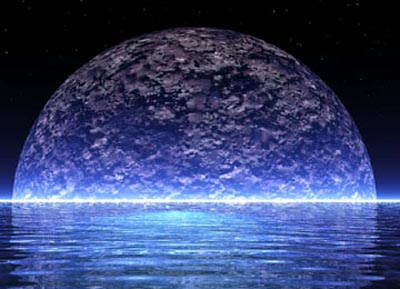 Ugo Rondinone Moonrise Ugo Rondinone, who was born in Switzerland in 1964 and today lives in New York, works in a number of widely differing media: photography, drawing, painting, sculpture and video are all equally represented in his artistic vocabulary. His orchestration of his diverse approaches to art production is such that the continual oscillation between heterogeneity and unity perfectly matches his themes. And this attitude is at the heart of Ugo Rondinone's project: to put into reality the desire to reinvent the world poetically. Characteristic of Rondinone's world are its ambiguities, which are carefully cultivated by the artist. It does not offer itself as an alternative universe: it is far too artificial for that. His art evokes insecurity, disorientation and the confusion of the senses. The viewer is sometimes conscious of being cast as a participant in a drama whose outcome can neither be controlled by him or herself nor the artist. All the artist does is lay out a path that leads nowhere and that sometimes feels oppressive, but sometimes also beguiling. To create this path, Ugo Rondinone in all his various media makes use of certain artistic strategies that upset, or even eliminate the usual ways of perception. These procedures sharpen the eye of the viewer, blurring the constricting limits of space, time or self-identity. A characteristic slowness often turns out to be a powerful moment of concentration. In his solo show entitled MOONRISE at Gallery Eva Presenhuber, Ugo Rondinone brings together four work complexes: MOONRISE, ALL MOMENTS STOP HERE AND TOGETHER WE BECOME EVERY MEMORY THAT HAS EVER BEEN, LOWLAND LULLABYE and THE DANCER AND THE DANCE. MOONRISE is made up of a series of masks cast in black rubber. The title of a single mask is combined from MOONRISE and the name of a month. A total of three different groups of 12 masks each have been produced. The title of the work ALL MOMENTS STOP HERE AND TOGETHER WE BECOME EVERY MOMENT THAT HAS EVER BEEN designates a series of 14 two-colour Perspex windows, each of which having as its own individual title a word of the full title. These masks and windows in the show inevitably enter into communication with the two installative sculptures on view, LOWLAND LULLABYE and THE DANCER AND THE DANCE. The multiform modules and elements of Ugo Rondinone's artistic vocabulary allow him to continually reformulate his own poetic world, to transform it into ever new images, to encapsulate it in new images in ever changing ways. Ugo Rondinone has often been called a romantic. This may be because the themes cherished by romanticism, dream and sleep, also play an important part in Rondinone's oeuvre. Thus, his sculpture LOWLAND LULLABYE does not really lay out a path leading nowhere, but rather establishes a platform for somnambulism. The brilliant surface consisting of square-shaped modules is covered and regularly structured by a pattern reminiscent of a web of waves. It evokes heights and depths. Five sets of loudspeakers specially built into the floor are playing the voices of a woman and a man. Their dialogue typifies a certain pattern of communication that ends up with each person not having the slightest idea what the other is talking about. No hint of sentimentality can be found in this work. In this situation, it is not absurd to see Rondinone's floor as cutting the ground from under the beholder's – or participant's – feet. In fact, this dynamic is deliberately staged in three movements: that of the wavy lines, that of the dialogue moving from one set of loudspeakers to the next, and finally that of the viewer walking around. The ultimate loss of firm ground becomes evident in the fact that the dialogue is played in an endless loop, and thus appears as a hopeless constant. The maze structure of THE DANCER AND THE DANCE consists of 16 modules. The wandering visitor is entertained by comic-like drawings of a raven, while the regular sound of breathing coming from the pillars has a soothing effect: the maze is perceived as a dim permanence. What looks like views of the outside world is nothing but Perspex panes reflecting their mirror images back into the universe dreamed up by the artist, with a collection of masks hanging on the walls impassively looking on. The visitor could not feel more alone than in front of these empty casts. All he or she can do is follow the artist and start exploring his or her own inner world. According to Samuel Beckett, the purpose of art must be to take care of humans in their philosophical dimension, with all their tendency to dream and fantasise, along with their wanderings. In the light of the rising moon, a groundless situation or a maze will turn out to be the kind of place where we are free to do just that. 23 August - 18 October 2003 Hours: Tue/Wed 12 am - 6 pm, Thu 12 am - 8 pm, Sat 11 am - 4 pm Galerie Eva Presenhuber Löwenbräum-Areal Limmatstrasse 270 8005 Zürich Telefon: 01 446 80 60 Fax: 01 446 80 65 E-Mail: info@ghwp.ch www.ghwp.ch |